VVAM Newsletter 66 – 1997
FRIENDS OF THE AIRBORNE MUSEUM
Editors:
Drs. R.P.G.A. Voskuil
C. van Roekel
G.H. Maassen jr.
Newsletter No. 66, April 1997
Translated by Cathrien and Peter Clark
Representative in Great Britain: Mr. E.E. Shaw, 298 Totnes Road Paignton – Devon TQ4 7HD Tel. 0803-553616
Walking excursion on Saturday 7 June 1997
A walking excursion is to be held on Saturday 7 June next which will follow a route along the western edge of the former allied 1944 ‘Perimeter’. Explanations will be given at various spots along the way.
The Perimeter covered the area in west Oosterbeek that was defended by British and Polish airborne troops against the Germans until the end of the battle.
The programme is as follows:
09.30 -10.00: reception of participants, with coffee, in the Airborne Museum, Oosterbeek.
10.00 -12.30: walk to various locations in
Utrechtseweg, Sonnenberg, Valkenburglaan, Van Borsselenweg and Westerbouwing. All participants need to be at ‘De Westerbouwing’ restaurant by 12.30 at the latest.
12.30 -13.30: lunch at ‘De Westerbouwing’.
13.30 -15.30: walk to various locations at Hemelse Berg, Pietersberg and Park Hartenstein.
There will still be time to visit the Airborne Museum on returning to the Hartenstein.
The ‘Events’ work group under the direction of Eugene Wijnhoud, ably assisted by a number of other members, is organising the walking excursion.
The cost of the excursion is 22.50 guilders, which includes coffee on arrival for the start, lunch at ‘De Westerbouwing’ and an extensive tour guide. Closing date for applications to take part is 24 May. The number of participants is limited to 100 and, as usual, applications will be handled on a ‘first come first served’ basis.
Treasurer Fennema retires
At the Society of Friends of the Airborne Museum’s recent AGM, Mr R. Fennema announced that he was stepping down as treasurer.
He has occupied this post for more than 15 years, since 20 March 1982 to be precise, and carried out the task with great care and in his own particular style. He will be succeeded by Eric van der Meiden from Oosterbeek.
We shall return to this ‘changing of the guard’ in the next Newsletter.
Reconstruction of a meeting between a British patrol and inhabitants of Oosterbeek during the Battle of Arnhem, for the poster for the ‘Onverwachte Gasten’ exhibition in the Airborne Museum ’Hartenstein’. In the background is De Tafelberg, one of the hotels used as an emergency hospital in September 1944.
(Photo: Berry de Reus, 13 March 1997)
Work Groups
Besides the Newsletter and Ministory editing team there are now two new Friends’ Society work groups.
They came into being on 1 January 1997 and are the ‘Events’ and ‘Publications’ work groups.
The first-named organises theme days and excursions, and consists of Eugene Wijnhoud (management member), plus Society members P. Stolte and M. van der Laan.
The second group looks after the production of all books and brochures planned for publication by the Society. This group comprises C. van Roekel (management representative), and Society members F. Miedema, J. Oorthuys, E. Eskes and M. Peters.
Opening of ‘Onverwachte Gasten’ (Unexpected Guests) exhibition
This year’s annual ’temporary’ exhibition in the Airborne Museum is entitled ‘Onverwachte Gasten’ and highlights the role of Oosterbeek hotels and boarding houses during the Battle of Arnhem. The exhibition opened on 25 April 1997
A pre-investigation, carried out with the help of the Renkum municipal archivist, showed that Oosterbeek possessed more than 100 hotels and boarding houses before the Second World War. It is impossible to tell the story of all these buildings in the space available, besides which there is nothing known about many of the hotels and, in particular, the boarding houses. Therefore a selection has been made.
In the exhibition the subject is brought to life through photographs, extracts from military and civilian diaries and via an extremely detailed and realistic diorama. Various Society members assisted in the organisation of this exhibition, or by the provision of material. The exhibition runs until 2 November 1997 and to mark it the Airborne Museum has produced a poster depicting an event that must have taken place time and time again during September 1944. It shows civilians giving information to an allied airborne patrol. See the photo on page 1 of this Newsletter.
‘Onbekend Herkend’ (The Unknown Identified)
The Airborne Museum is organising a special day on Saturday 21 June 1997 under the name ‘Onbekend Herkend’. On the day, museum visitors can bring along, for them, unknown military and civilian objects and documents that have a (possible) connection with the Second World War.
A team of experts will be on hand between 11.00 and 16.00 to attempt to identify the objects. They will also provide as much background information as possible. No value will be placed on the items and documents as this is only relative.
(W. Boersma)
Slit trenches protected
For some time the Friends’ Society has been making great efforts to ensure the protection of several groups of slit trenches from September 1944 that are still to be found in the woods in and around Oosterbeek.
Last February the society management received a letter from the Forestry Commission stating that the slit trenches in the northeast corner of Johannehoeve are now on the protected list. The trenches will be borne in mind during any possible future work in the wooded areas concerned.

Oosterbeek, 19 February 1997. Author Cor Janse (centre) presents the first copies of his second book, ‘Blik Omhoog’, to Philip Reinders and Peter Vrolijk in the Airborne Museum, in appreciation of their valuable help.
(Photo: Berry de Reus)
Presentation of ‘Blik Omhoog’ (Glance Skywards)
It was long awaited and now at last it’s here; the second part of Cor Janse’s book on the history of Wolfheze village during the Second World War, ‘Blik Omhoog’. This second book in the proposed three- book series deals entirely with the Battle of Arnhem in so far as it involved the village and its surroundings.
‘Blik Omhoog II’ received its baptism at a well- attended meeting in the Airborne Museum on 19 February 1997. Following an introduction by the author the first two copies of the book were presented to Philip Reinders from Vlaardingen and Peter Vrolijk from Rotterdam. These two, members of the ‘Arnhem Battle Research Group’, freely provided the author with information relating to the fighting in Wolfheze during September 1944 from their vast collection.
One of the least known aspects of the Battle of Arnhem is the series of bombing raids on Wolfheze, Oosterbeek, Arnhem, Ede and Wageningen which preceded the airborne landings on 17 September 1944. Through the study of previously unpublished documents from American archives, and correspondence with former Flying Fortress aircrews, Cor Janse has succeeded in being the first to paint a clear picture of these air raids. Besides reports, the book contains unique aerial photographs taken from the American bombers during the raids. The attacks had disastrous consequences for Wolfheze; dozens of civilians fell victim and material damage was tremendous.
Over the years Cor Janse has managed to track down hundreds of old Wolfheze inhabitants, both in the Netherlands and abroad. His new book presents many of the stories told to him about the bombardments and subsequent fighting, and these personal recollections form the basis of the book.
The third book in the trilogy will deal with the period of the evacuation of the civilian population after the Battle of Arnhem, the liberation and the return of the population in 1945. When this will be published is not yet known, but it is intended to round-off the project in 1997.
Blik Omhoog II’ comprises 428 pages, approximately 200 illustrations, and is available from bookshops in the municipalities of Arnhem and Renkum as well as from the Airborne Museum ‘Hartenstein’. It costs 44 guilders.
From the Airborne Museum 1996 Annual Report
* The Airborne Museum received 54,060 visitors in 1996. Of these 52,676
were paying visitors while 397 Arnhem veterans and 987 Friends’ Society members visited free of charge.
* A visitors poll was held during the months of July and August. The results, which are compared with those of polls held in 1992 and 1993, will help form the basis of future policy.
* A steel filing cabinet in which the items are separated from one another by sheets of acid-free paper is now being used for the storage of the newspaper and magazine collection. The newspaper archive for the period September 1944 to June 1945 contains 376 items.
* By means of an exchange action (copies of) unusual archive material and photographs have been obtained from Fulbeck Hall, the former headquarters of the 1st Airborne Division in Lincolnshire, England.
Diploma for Roland Boekhorst
Roland Boekhorst, a full-time Airborne Museum employee, recently, and successfully, completed the course for museum conservators. He obtained his diploma after following a two-year course at the Gelders Opleidingscentrum (Gelderland Education Centre) in Veenendaal.
The course included a number of working visits to various museums throughout the Netherlands. Some of those taking the course also visited the ‘Hartenstein’ museum as part of their studies.
The managements of the Airborne Museum Foundation and the Friends’ Society would hereby like to congratulate Roland on the award of his diploma!

Airborne Museum, 27 March 1997. Curator Berry de Reus receives Dr Frazer’s medal set and medical instruments from the hands of John Buis from Canada. On the right is Mr A. Groeneweg, member of the museum foundation management team.
(Photo: Robert Sigmond)
Book Fair
The annual book fair will be held in the Airborne Museum on Saturday 31 May next between 11 am and 4 pm. Stands selling second-hand books on World War II will be set up at various places in the building. The Society of Friends of the Airborne Museum will also be present with a stand selling books about the Battle of Arnhem. Many older books on this subject have been out of print for many years and are difficult to find, but rare titles do often come to light at the book fair.
Members of the Documentation Group ’40 – ’45 will be there as well with a number of sales stands. During the fair it will also be possible to register titles for which one may have been searching a long time. The museum will pass such titles on to the various societies having expertise in the subject in question. Last year more than 300 people visited the fair; there were around two thousand books on offer.
(W. Boersma)
Gift of ‘Pilots Flying Log Book’
Mr G. Raymond McLaren recently presented the Airborne Museum with a number of newspapers, photographs and the ‘Pilots Flying Log Book’ of his brother, Staff Sergeant W.C. McLaren.
William C. McLaren was a glider pilot with ‘F’ Squadron, 2nd Wing, Glider Pilot Regiment. He was killed on 19 September 1944 in Lower Oosterbeek, close to tire Arnhem/Nijmegen railway line. He was buried in a temporary field grave to the south of Hotel de Tafelberg in Oosterbeek. He now rests in the Airborne Cemetery, grave number 3 D 9.
(W. Boersma)
Unique acquisition
On 27 March 1997, the medical instruments and medal set belonging to Doctor S.M. Frazer were presented to the Airborne Museum. Major Frazer was the deputy commander of the 181st Airlanding Field Ambulance in September 1944. In the years before his death he was registered as a resident of the Bermudas, where his widow still lives.
While on a visit to the Bermudan islands, Canadian John Buis heard that Dr Frazer’s widow still had her husband’s medal set as well as the medical instruments used during the Battle of Arnhem. He contacted the curator of the Airborne Museum, Mr Berry de Reus, whose enthusiasm for the plan to get these items to Oosterbeek was immediate and unbounded!
Thanks to the co-operation of Dr Frazer’s widow and the efforts of Berry de Reus and John Buis, these unique objects now have a new home in the museum.
There will be more on this gift in the next Newsletter, (see photo on page 3).
Museum obtains ‘Phantom’ emblem
The Airborne Museum has recently obtained an extremely rare sleeve emblem of the allied ‘Phantom’ unit, sections of which were involved in Operation Market Garden in September 1944. Their task was to report the progress of the operation directly to allied headquarters. During the Battle of Arnhem this was only partially successful.
(W. Boersma)
Reaction to Ministory No. 51
In Ministory No. 51, Tom Henney described, among other things, the withdrawal across the Rhine during the night of 25/26 September 1944. He described the boats used in the withdrawal as ‘…canvas boats manned by Canadian Engineers..’
The editors have received a letter from Mr F.J. Petrie M.M. from Cirencester in England with the following interesting comments:
‘This description reveals an understandable confusion in the memories of many veterans whose eye-witness accounts variously describe the boats as “powerboats – collapsible wood and canvas affairs with motors – small rowing boats – boats paddled like Red Indians – canoes – amphibious vehicles – DUKWs.”
As I was the British sapper who took the first boat across the river at the most westerly ferrying point that night, may I be allowed to describe the two types of boat actually used, and to name the British and Canadian sapper (Engineer) units which participated.
In the case of my own unit, 553 Field Company Royal Engineers (43rd Wessex Infantry Division),two platoons were detailed for the operation with a third platoon being kept in reserve. I expect that the other Wessex Division sappers involved, namely 260 Field Company Royal Engineers, had the same platoon strength, and also that the manpower of the two Independent Canadian Companies, the 20th and 23rd Field Companies of the Royal Canadian Engineers, was similar. This gave a comparable British and Canadian sapper involvement at their four respective ferrying points.
The two Canadian Companies operated stormboats, which were of wooden construction and powered by outboard motors. A stormboat was 20 feet long and six and a half feet in width. It’s operating capacity was 13 fully armed men with a crew of two. The speed of the boat was 20 knots empty and 6 knots fully laden.
The two British Companies operated assault boats, as these were the boats normally carried by an Infantry Division. An assault boat was of collapsible canvas construction with a timber gunwale and wooden frame and floor. The sides when raised were supported by wooden struts. This craft was almost 17 feet in length and five and a half feet wide. It’s operational capacity was 12 fully armed men with a crew of 2 using paddles, not oars.
I would add that during the night and early morning of the operation, because of the difficult river conditions, the British crews paddling the assault boats had first to be increased to three men, then to four and finally to eight men.’
The Arnhem Library ‘Market Garden’ collection
The Arnhem Library possesses a huge and valuable collection of literature on Operation ‘Market Garden’. For this collection, which at the moment comprises 1730 titles, only material related to tire fighting in the province of Gelderland has been selected, not, therefore, on the airborne landings and advance of the allied ground forces in the North Brabant newspaper and magazine articles, photographs regimental histories, OS maps, reports, ‘ commemoration programmes and so on.

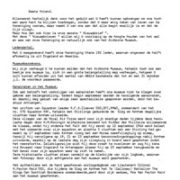
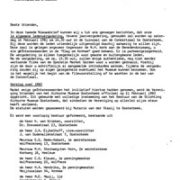
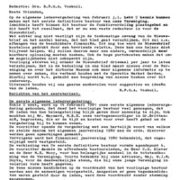
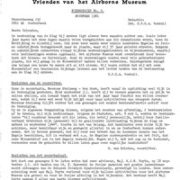
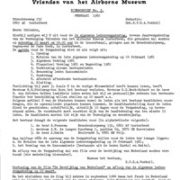
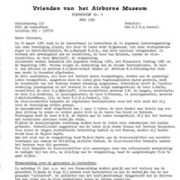
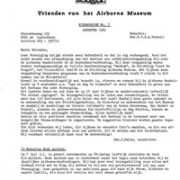
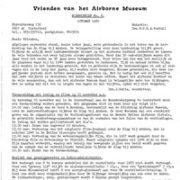
Plaats een Reactie
Vraag of reactie?Laat hier uw reactie achter.